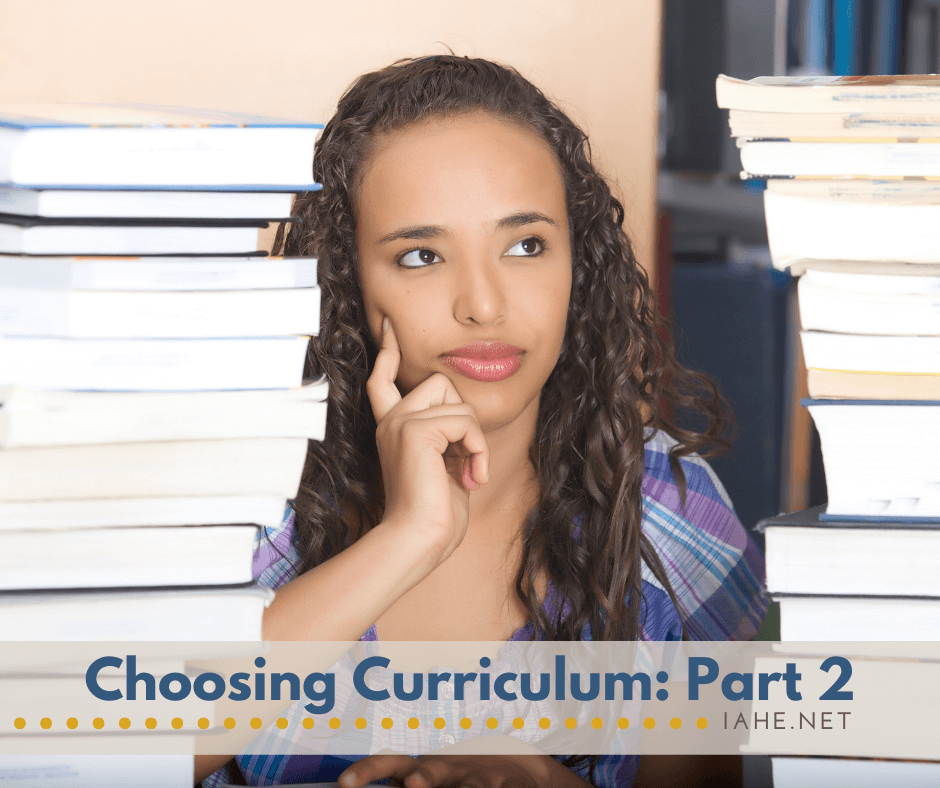
Curriculum Styles
This is Part 2 of a two-part series on choosing curriculum for elementary and middle school. Read Part 1 HERE.
In PART 1 we explored why you have chosen to homeschool, your educational philosophy, and your vision for your homeschool. Part 2 will go over the common styles of curricula.
Some curricula are designed for specific individual homeschool styles; others can be used across many different styles with ease. Read about Homeschool Styles to find out more!
Teacher vs. Student
It is important to keep in mind both yourself and your child as you evaluate curriculum. If you will be doing the majority of the teaching, you want to make sure you like the curriculum you choose. Of course, you want your children to like it as well, but if you as the teacher don’t understand it, find it frustrating to use or keep organized, or just plain don’t like the way things are written, then you may lose some of the joy of learning with your child. And your child may very well sense your frustration and dislike.
Consider your own teaching style. Do you enjoy lectures and verbal discussion? Do you like reading and discussing books? What are your thoughts on hands-on crafts and experiments? How much control do you want over planning lessons?
Also consider your child. Does she learn well with open verbal discussion? Maybe choose a curriculum that encourages plenty of interaction and thoughtful discourse. Does he enjoy learning from worksheets? Then you may choose a curriculum that’s heavily worksheet-based. Does she love crafts and all things creative? You could choose one or two subjects and look for publishers that offer that crafty outlet. Taking time to understand how your child learns best and finding curricula that aligns with that will pay off in the end.
Make the Curriculum Work for You
You don’t need to force yourself to make every subject crafty, or avoid even the word ‘worksheet’ just because your child prefers one style over another. You can mix and match, add variety, skip sections and add in others, add crafts or worksheets (or remove them). Make the curriculum serve you, not the other way around.
If you find yourself spending too much time organizing papers, checking boxes, or fretting that you’re behind the pre-printed schedule, maybe you need a program with less structure that is presented in a different way (but not necessarily lesser quality academics). Do you feel lost, completely unstructured, and fret every day about “Now what do I teach next? Where do we go from here?” Consider adding some structure to your curriculum. You could get a calendar or planner and list the lessons you want to accomplish each week.
Textbooks
Likely these are what you know and remember from your own school days. Traditional textbooks are assembled by larger publishers, usually on a single topic for an entire school year.
Often, textbook curricula come with detailed teacher’s guides, pre-made daily and weekly assignments, timetables, test and quiz booklets, and possibly online or dvd components. Textbooks can often be purchased by individual subject.
All-In-One
Also called “boxed curriculum”, all-in-ones are just what they sound like—all the subjects under one roof. These curricula will usually have most or all the subjects pre-packaged for you, with a daily teacher’s guide and assignment book. Additional materials like science kits and craft materials may or may not be included. Some all-in-ones will leave out a subject or two, which you will need to select on your own.
Some all-in-one programs provide minimal materials, and instead sell booklists and references, leaving you to assemble the individual materials yourself. These are usually significantly lower-priced than a traditional boxed curriculum because you can seek out books and materials used or purchase cheaper locally. These usually have limited online components. Sometimes you also must make your own schedule and lessons; others have daily or weekly lessons available.
It is worth pointing out that companies that sell all-in-one packages, frequently offer single subjects as well.
Individual Subjects
These curricula cover only one subject area. Math or reading or science, etc. You may choose several different publishers to cover all subjects. Individual curricula can be textbooks, unit studies, hands-on projects, or just lists of books and materials to be found on your own.
Each publisher will present material in a different format.
Some math, reading/phonics, and spelling publishers will offer short placement tests on their websites to help you select the correct level for your student. Remember that each publisher sets their own standards, so Level 1 in one math program may not be the same in others. You may need to do more than one placement test across multiple publishers.
Online
These programs will be mostly or all online-based. This can mean all work will be done through videos, online game modules, online worksheets, live or recorded lectures and classes, or through apps on your phone or tablet.
In some cases, an online curriculum will mean printing off worksheets or linking to other websites for individual lessons. Some online programs have a specific set schedule, while others are self-paced. Online programs can also be all-in-one or individual subjects.
Independent Learning
This style is designed for individual students to move through mostly or completely independently. Curriculum in this style may include any or all of these features: lessons that are written directly to the student, videos that are made specifically for the student, lesson plans that lay out a clear schedule and checklist, etc.
This style may be best suited for older students or children who are mature enough to keep themselves on task and don’t need a lot of parental supervision over the details of each day.
Accredited Schools
Accreditation is a designation given to schools by state, regional, and national accreditation agencies to certify that the school meets or exceeds the standards for education by that organization including evaluation of teaching licensure and credentials, administration, curriculum content, finances, instructional methods, etc. Public schools are accredited by their individual State Board of Education.
Individual curriculum cannot be accredited.
In Indiana, homeschoolers are not required to use an accredited school for homeschooling.
Try Something New or Create Your Own
Most of us would like to find the perfect curriculum for our family on the first try. However, the reality is that it might take a little trial and error. Hopefully, this article will give you a good idea of what to look for, but you still may find mid-year that a certain curriculum just isn’t working for you or your child. It’s ok. It happens to all of us.
You may find you can tweak the curriculum enough to finish the year, but if you can’t, it may be worth trying something new after a little more research.
If you find that some curriculum is too confining for you, maybe you would enjoy creating your own curriculum. You could use a variety of resources such as, but not limited to, books from the library or book stores, videos, maps, workbooks, timelines, crafts, online resources, etc.
The freedom we have in homeschooling is incredible! There are endless possibilities today for you to choose from. That can be confusing, but it also means there are endless ways to customize your child’s education.
Wrap Up
So, you’ve thought about your homeschool and educational philosophy, you’ve read about homeschool styles, and you’re familiar with the major types of curriculum.
Now, close your eyes tightly and whisper the magic words very quietly: I can do this!
Part 1 helped you identify why you’re homeschooling and helped you think about what is education and how it can look different from the traditional public school model.
Part 2 introduced you to Making the Curriculum Work for You and showed you the styles of curriculum.
Information overload can be very real, especially when looking at curriculum. Keep a notebook and jot down names, publishers, and particular elements you like or dislike as you explore. And every so often, be sure to put away the computer and go do something else. There is more to life than curriculum!
For a much deeper dive into curriculum, homeschool styles, and planning your homeschool, including a printable workbook, check out Homeschool University’s Start Strong Indiana. This 14-day self-paced online course walks you through every step of homeschool, from laws and requirements, to curriculum and styles, to time management, to a vision for the future.
